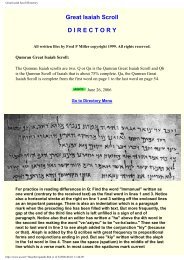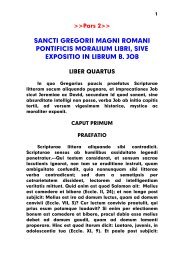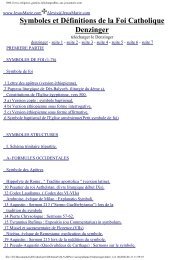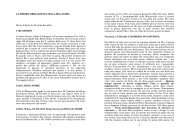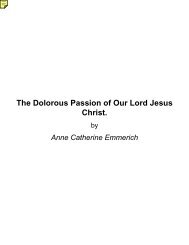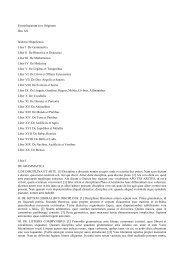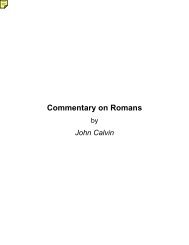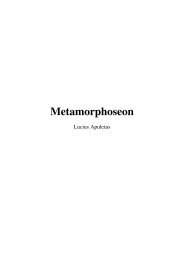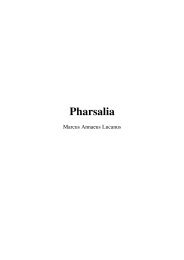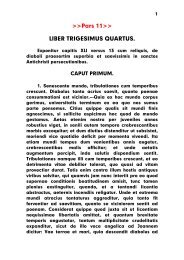Commentary on Psalms - Volume 3 - Bible Study Guides
Commentary on Psalms - Volume 3 - Bible Study Guides
Commentary on Psalms - Volume 3 - Bible Study Guides
- No tags were found...
You also want an ePaper? Increase the reach of your titles
YUMPU automatically turns print PDFs into web optimized ePapers that Google loves.
Comm <strong>on</strong> <strong>Psalms</strong> (V3)John Calvinauthor of this psalm 596 — as if it were credible that his posterity should have set themselves up inrebelli<strong>on</strong> against him.Psalm 92:12-1312. The righteous shalt flourish like the palm-tree, 597 he shall be multiplied as the cedar inLeban<strong>on</strong>. 598 13. Those who are planted in the house of Jehovah shall flourish in the courts of ourGod. 14. They shall still bud forth in old age; they shall be fat and green; 15. That they may showthat Jehovah is upright, my rock, and that there is no iniquity in him.12 The righteous shall flourish like the palm-tree. He now passes to the c<strong>on</strong>siderati<strong>on</strong> of anothergeneral truth, That though God may exercise his people with many trials, subject them to hardships,and visit them with privati<strong>on</strong>s, he will eventually show that he had not forgotten them. We neednot be surprised that he insists so explicitly and carefully up<strong>on</strong> this point, as nothing is more difficultthan for the saints of God to entertain expectati<strong>on</strong>s of being raised up and delivered when they havebeen reduced almost to the state of the dead, and it does not appear how they can live. Some thinkthe cedar is menti<strong>on</strong>ed from the fragrancy of its smell, and the palm for the sweetness of its fruit;but this is too subtile a meaning to attach to the words. The sense seems simply, that though therighteous may appear for a time to be withered, or to have been cut down, they will again springup with renewed vigor, and flourish as well and as fair in the Church of God as the stateliest treesup<strong>on</strong> Leban<strong>on</strong>. The expressi<strong>on</strong> which is employed — planted in the house of the Lord — gives thereas<strong>on</strong> of their vigorous growth; nor is it meant that they have merely a place there, (which can besaid even of hypocrites,) but that they are firmly fixed, and deeply rooted in it, so as to be unitedto God. The Psalmist speaks of the courts of the Lord, because n<strong>on</strong>e but the priests were allowed596 These Rabbins say that Adam composed it immediately after the creati<strong>on</strong> before the Sabbath. The Chaldee paraphraseentitles the psalm, “A hymn or s<strong>on</strong>g which the first man spoke c<strong>on</strong>cerning the Sabbath-day.” But had it been a compositi<strong>on</strong> ofAdam’s, <strong>on</strong>e would think it should have been placed at the head of this collecti<strong>on</strong> of psalms. Besides, there were no musicalinstruments at that time for this psalm to be sung up<strong>on</strong>, (see verse 3;) for Tubal was the father of them that handle the harp andorgan; nor, as Calvin observes, had Adam numerous enemies and wicked men who rose up against him, to which reference ismade in verses 7, 9, 11. We may therefore justly regard the Jewish traditi<strong>on</strong>, which ascribes the compositi<strong>on</strong> of this psalm toAdam, as fabulous, having no other foundati<strong>on</strong> but the inventi<strong>on</strong> and fancy of some of their Rabbins.597 The palm is <strong>on</strong>e of the noblest and most beautiful of trees. It is more remarkable than any other tree for its straight, uprightgrowth, and hence its Hebrew name tamar It frequently rises to the height of more than a hundred feet; and its leaves, whenit arrives at maturity, are often six or eight feet in length, and broad in proporti<strong>on</strong>. At the age of thirty it attains its greatest vigor,and c<strong>on</strong>tinues in full strength and beauty for seventy years l<strong>on</strong>ger, producing every year about three or four hundred weight ofdates. It is crowned at the top with a large tuft of spiralling leaves about four feet l<strong>on</strong>g, which never fall off, but always c<strong>on</strong>tinuein the same flourishing verdure. And it has been said that when loaded with any weight it possesses the quality of resisting it,and of rising upwards and bending the c<strong>on</strong>trary way, to counterbalance the pressure. This tree, then, so distinguished for itsuprightness, loftiness, fecundity, l<strong>on</strong>gevity, perpetual verdure, and power of resistance, is employed with great elegance toexpress the spiritual beauty, elevati<strong>on</strong>, fruitfulness, c<strong>on</strong>stancy, patience, and victory of the righteous.598 The cedars of Leban<strong>on</strong> are a favourite image with the sacred writers. They grow to a prodigious size, rise to an enormousheight, and spread their branches to a great extent, affording a grateful shade. They c<strong>on</strong>tinue to flourish for more than a thousandyears; and, when cut down, their wood is so durable that it has obtained the reputati<strong>on</strong> of being incorruptible. How striking, then,the image, “The righteous shall grow like a cedar in Leban<strong>on</strong>,” like that massy, lofty, umbrageous, and incorruptible tree, whichc<strong>on</strong>tinues to flourish from generati<strong>on</strong> to generati<strong>on</strong>, which survives empires, and is still vigorous when a thousand years havepassed over it.303



